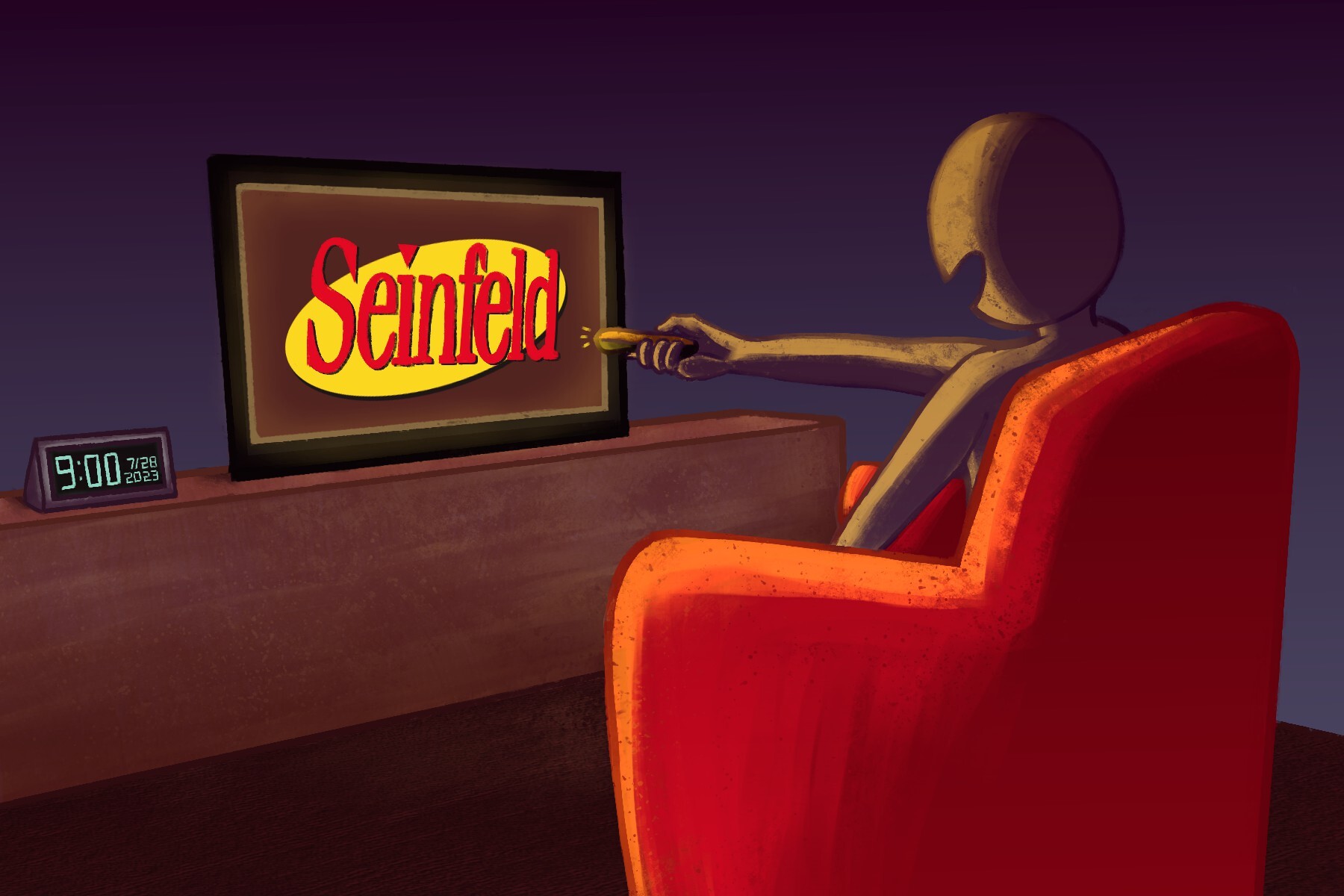How does a television show stay relevant after its original run ends? What makes one show more influential than another over a long time period? The formula for small screen immortality lies in the comprehensive genius of the landmark 1990s sitcom “Seinfeld.”
Created by Larry David and Jerry Seinfeld, “Seinfeld” premiered in July 1989. The show has sustained its popularity over multiple decades, and its nine seasons remain ingrained in the public consciousness. There is no question that its availability on Netflix is part of the reason why people still watch the show. But “Seinfeld” boasts merits of its own beyond accessibility in the content-saturated digital age.
The show’s focus on the minutiae of New York City life has led viewers to call it the “show about nothing,” but “Seinfeld” still survives because each episode has a strict plot structure. The four main actors’ singular chemistry and the show’s masterful ability to capture and develop the cultural zeitgeist of 1990s America are integral to the sitcom’s timeless appeal.
The Acting
Jerry Seinfeld plays a fictionalized version of himself in the show. While Seinfeld’s acting abilities have never been great, his quick-witted dialogue is key to the show’s continued success. Jason Alexander plays George Costanza, a short, stocky bald man and Jerry’s best friend. The show’s writers based George’s character on the personality of co-creator Larry David. Costanza’s performance captures the cynical undertones beneath David’s outward exuberance.
Michael Richards plays Cosmo Kramer, Jerry’s wacky neighbor from across the hall. The actor used slapstick humor and impeccable comedic timing to craft his memorable performance. Julia-Louis Dreyfus rounds out the cast with her portrayal of Elaine Benes, Jerry’s former girlfriend. Elaine provides a fascinating and necessary female perspective to the male-dominated cast.
A fundamental comedic element in “Seinfeld” is Michael Richards’ slapstick comedy as Kramer. Actors like Charlie Chaplin and the Three Stooges perfected the art of slapstick, using their entire bodies to convey and hyperbolize moments of human ineptitude. Michael Richards followed in the footsteps of this long comedic tradition with his signature slam into Jerry’s apartment door. Richards would pound through the door of the apartment set, slide across the wood floor and assume a comedic posture the moment his character entered. His over-the-top slides into Jerry’s apartment help to both introduce new scenes and cement the audience’s engagement with the show. Kramer’s entrances became so legendary that the studio audience’s applause would last for minutes before the cast could continue with the scene.
The Writing
Plot Structure & Pacing
The show succeeds because it features multiple storylines that inventively collide toward the end of each episode. A good way to examine the sitcom’s stellar writing structure is to take one ordinary episode, such as “The Scofflaw” (Season 6, Episode 13), and track its plot. This episode introduces storyline A when George talks to his old friend Gary Fogel and discovers that Gary has cancer. Storyline B then immediately begins when the show cuts to Kramer calling a cop a “pig” by mistake. The episode then cuts back to storyline A as Jerry reveals to George that he has known about Gary Fogel’s cancer for months, which leads to this winning one-liner:
George: Was he on his death bed?
Jerry: No, he was on his regular bed.
Elaine then enters the apartment, revealing that Jerry only told Elaine about Gary’s cancer because George is unable to keep a secret. Storyline C commences when Kramer asks Elaine about her ex-boyfriend Jake Jarmel’s glasses, which kickstarts an elaborate revenge plot wherein Elaine searches for and successfully acquires a pair of glasses identical to her ex’s rare spectacles from a random passerby. The episode then fleshes out Storyline B when Kramer explains to the cop that he was calling someone else a pig, not him, prompting the cop to recount his tale of the “White Whale.” The perpetual scofflaw, who evades parking tickets, is someone the cop has been tracking for many years — an obvious parody of Herman Melville’s “Moby Dick.”
All the action previously described occurs in about five minutes of television thanks to the sitcom’s extremely concise writing. From there, the plots begin to interweave and build toward some excellent comedic conclusions.
Inventive Storyline Collisions
The first great plot intersection happens when George is driving his car. He narrowly escapes getting into an accident with the same random person from whom Elaine obtained the glasses. This causes a street disturbance that distracts the cop from nearly apprehending the “White Whale,” so the scofflaw escapes — partially because of Elaine’s revenge plot. The A, B and C storylines all collide briefly before diverging once again.
Eventually, the audience finds out that the scofflaw is none other than Newman, Kramer and Jerry’s neighbor (whose stupidity and deviousness are the bane of Jerry’s existence). Kramer convinces Newman to turn himself in, so the storyline B plot ends when Newman receives his sentence: he must park his car in a garage. In New York City, this punishment could lead to bankruptcy because of the exorbitant expense of parking.
Meanwhile, Storyline C wraps up when Elaine gets full revenge on her boyfriend in a glorious public display.
The final plot collision happens at the end of the episode. Storyline A develops when George finds out that Gary has been lying the whole time about having cancer. Jerry wants to confront Gary about his deception but cannot because Gary offered George an inexpensive parking spot. Parking is a central issue in both the A and B storylines.
The final reveal of the episode occurs when Gary tells George that he cannot, in fact, offer him a parking spot, as some scofflaw needs it to park his car. This wonderful weaving of storylines A and B concludes with Jerry finally getting the confrontation he wants. George allows him to challenge Gary because of this new development.
This extensive summary of “The Scofflaw” illustrates just how complicated and innovative the “Seinfeld” plots are. The writers churned out 20 plots just like this each year, so “Seinfeld” constantly needed new writing staff to maintain its excellent quality.
The Zeitgeist
“Seinfeld” has left an indelible imprint on pop culture and the American mind frame. The show’s writers either invented or popularized phrases such as “yada yada,” “serenity now,” “double-dipper,” “low talker” and “close talker.” Critics and audiences regard “The Contest” as one of the greatest episodes in television history given its innovative use of euphemisms to simultaneously convey sexual content and escape the censures of broadcast television.
Four upper-middle-class New Yorkers ultimately made an intimate connection with viewers worldwide. Even though most of its plots derive from issues specific to New York, the show still manages to convey greater human dilemmas and burst through the boundaries of traditional sitcoms. Brilliant writing and acting combine to make a timeless sitcom whose greatness audiences must see to believe.
“Seinfeld” is available to watch here on Netflix.
















